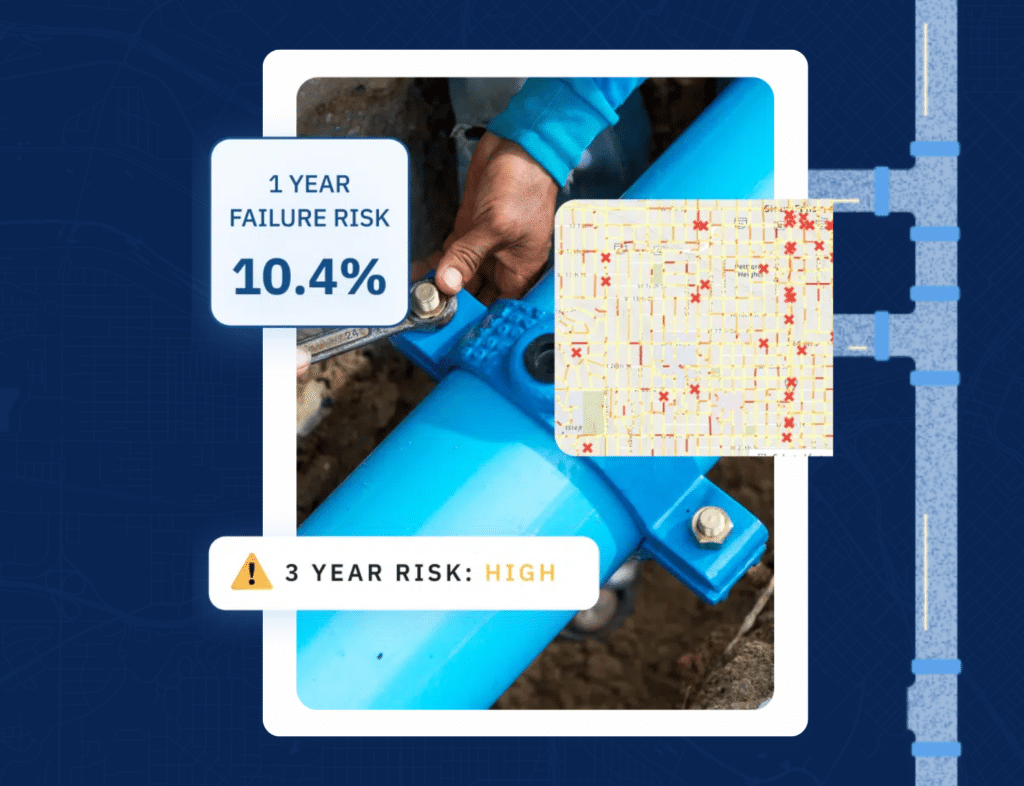Water system managers are constantly making decisions about how to assess, maintain, and replace their water mains. Often, these decisions are made using a few data points (ex, age of the water main) combined with qualitative insights from those who know the system best.
Predictive modeling doesn’t displace these existing processes. But it does significantly improve your data which, in turn, improves your understanding of the infrastructure you manage. This enables you and your team to make better, more informed, more efficient, more defensible decisions on behalf of your customers (and to easily explain those decisions to internal and external stakeholders).
So how can predictive modeling actually help you manage your water mains?
1. Get ahead of the growing need as your infrastructure ages
According to the recent Water Main break study from Utah State, US and Canadian water systems can expect to see 260,000 water main breaks annually, representing ~$2.6 billion per year in maintenance and repair costs, plus an average of 11% water loss due to leakage. You already know this better than anyone; aging infrastructure remained a top concern for the water sector in the AWWA’s 2024 State of the Water Industry survey.
As assessment, maintenance, and repair costs and demands increase, efficiently targeting limited resources is critical. Better data and geographic understanding of likely leaks and breaks gives you the information you need to make more targets, informed decisions about how to plan and take action.
2. More accurate than single heuristic models
Many water systems and engineering firms currently rely on just a few heuristics, such as the age of the main, to anticipate the likelihood of failure for each main. While age is an important factor in likelihood of failure, making decisions based on age alone means you’ll spend time and money on repairing old mains that are unlikely to break and risk catastrophic failure of deprioritized mains.
Every water main has a unique profile across hundreds of variables, including things like soil type, past history of repair, material type, freeze and precipitation patterns, etc. Custom machine learning models, such as BlueConduit’s new Water Main Predictions solution, take all of this data about your water mains and the physical space they inhabit. Then, with the support of data scientists focused on model performance and accuracy, the models are able to detect patterns to discern which mains are likely to leak or break across various timelines.
3. Better, smarter data to drive Condition Assessments and water loss audits
If you only wait to repair/replace until after a water main breaks, you risk a catastrophic failure leading to states of emergency, boil water notices, loss of public trust, and more (recent examples here and here). Many water systems are already taking a proactive approach to assessing the conditions of their water mains, or auditing mains to understand water loss. For these systems, likelihood of failure predictions help guide physical assessment decisions, allowing managers to hone in on mains needing maintenance or replacement with the highest efficiency.
Target appropriate resources for water mains maintenance and replacement
With aging infrastructure, the cost of water main maintenance and replacement will continue to increase in the coming years. Understanding the likelihood of failure across your full system and across multiple timelines enables dynamic planning and empowers water managers to make more compelling requests for additional dollars to support this critical work.
As a water system manager, you know your water system better than anyone. But limited data reduces your ability to make the best decisions on behalf of your customers. That’s where we come in. BlueConduit’s local, dynamic predictive modeling technology, supported by our expert Data Science team and delivered in Esri, gives you the data you need to make the best, most efficient decisions based on your unique community needs.
Ready to learn more about how BlueConduit’s predictive modeling technology can enhance your water main planning and process? Reach out to schedule a conversation today.






